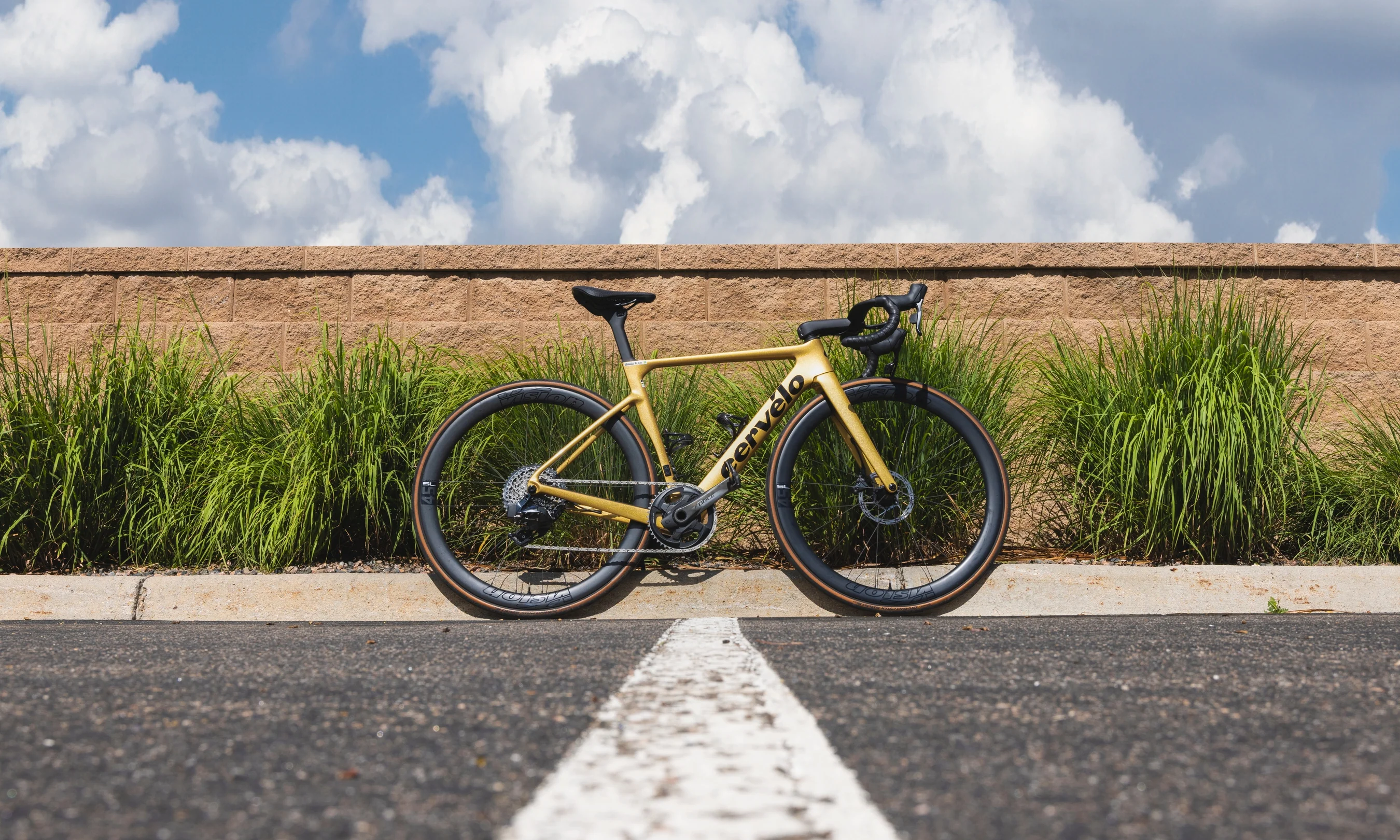Is your heavy bike making you depressed? You’re not alone. Many cyclists dream of having the lightest bike possible. It’s the primary motivation of "weight weenies," people who count grams obsessively.
When it comes to improving a bike’s performance, weight is tangible. We feel it every time we pick up a bike. We can put a bike on a scale, get a number, and determine that a smaller number is “better.” We can spend money on new components that save more weight. As consumers, we can control and modify road bike weight in ways we can’t with variables like stiffness, aerodynamics, or geometry.
But does bike weight really matter? Weight weenies would say yes. But the real answer is far more nuanced. Weight is only one factor of many that affect bike performance. It may surprise you to learn that it's also rarely the most important factor. Let’s take a deep dive into the subject of bike weight and look at the costs, value, and what real riders think about saving weight on their own bikes.
[button]Shop Road Bikes[/button]
The high cost of lightness
Rocket scientists are the world’s ultimate weight weenies. When sending objects into space, they deal with the “tyranny of the rocket equation." As the amount of weight they want to move increases, the rocket fuel required to do so increases exponentially. For example, increasing a rocket's payload by only 5% may require a massive 130% increase in fuel to move it. Because of this problem, minimizing rocket weight is paramount. Aerospace materials are made to be as strong and light as possible to balance the equation, and they’re hugely expensive because of it.
Of course, bikes aren’t rockets, but plenty of riders treat them like that. Trimming off excess weight can become an obsession. Some riders might believe that a matter of a few grams will be the difference between a great bike and a mediocre bike, or winning and losing. An inconsequential component might go under the microscope and hundreds, maybe thousands of dollars could be spent to save less than a pound.
Take the water bottle cage, for example. A metal bottle cage might weigh only 30 grams more than a carbon one. But the carbon cage will cost significantly more. You might spend $70 for a carbon cage versus $10 for a metal cage. Say you have a fairly light, 17-pound road bike. If you choose the carbon bottle cage, you’re spending seven times more money to shave off a negligible amount (0.4%) of your bike’s total weight. The math is similarly bad for most weight-focused upgrades.

It's bad for complete bikes too. For example, a top-of-the-line Specialized S-Works Tarmac retails for over twice as much as a similar Tarmac Expert. This higher price gets you a lighter frame and lighter components. But the S-Works model is not twice as light. The weight difference is only one or two pounds. You’re paying over 130% more, to save about 5% of the total weight.
This could be seen as the "tyranny of the bike equation." As bike weight decreases, the cost of increases exponentially. Being a hardcore weight weenie not only requires a lot of dedication but also a lot of money.
[newsletter]
The value of a light bike
But is spending money to make your bike lighter worth it? It’s hard to say exactly when reducing a bike's weight actually becomes noticeable. You could probably tell if your bike suddenly became 10 pounds lighter, but would you notice if your bike became only one pound lighter?
The water in a small 20oz bottle weighs a little over a pound. Do you ever notice if you’re riding with a full versus an empty bottle? If not, then you probably won’t be able to tell that a pair of carbon handlebars are 100g less a pair alloy ones. It will take a lot of component upgrades throughout a bike and a lot of money for all those saved grams to add up to a percievable reduction in overall weight.

But even if small reductions can’t be felt, the fact remains that a lighter bike requires less power to move. Especially on climbs, the power-to-weight ratio of bike and rider plays a huge part in overall performance. Even if it’s a small difference of only a few watts, it could matter in a race situation. Take two riders with the exact same fitness and body weight. The rider with the lighter bike will hypothetically make it to the top of a climb first, or they’ll have to expend slightly less power to reach the top at the same time.
There are limits to this, however. Rider weight is far more important in the bigger picture because riders far outweigh their bikes. A 180-pound rider on a 20-pound bike results in an overall weight of 200 pounds. The rider is 90 percent of that weight. This is why really good climbers are generally skinnier or smaller than average riders.
| Rider + 18lbs bike | % Improvement with 1lbs less | % Improvement with 5lbs less |
| 138lbs (120lbs rider) | .7% | 3.6% |
| 168lbs (150lbs rider) | .6% | 3.0% |
| 198lbs (180lbs rider) | .5% | 2.5% |
The best lightweight bike upgrade
If you are going to spend money on a single weight-saving upgrade for your bike, start with wheels and tires. They’re generally considered the best place on the bike to shed grams because wheels and tires are rotating weight. Additional weight increases inertia and wheel inertia matters a lot in cycling because the rider has to overcome it to accelerate. Heavier wheels require more energy to overcome this inertia. Many riders, even novices, can feel the difference when riding lighter wheels. They make a bike feel snappier and easier to accelerate.
Carbon wheels are one of the most popular aftermarket upgrade options for both road and mountain bikes. Carbon fiber is exceptionally light, stiff, and strong. Because of carbon’s strength-to-weight advantage, road bike rims can be made deeper, wider, and more aerodynamic, without a massive weight penalty. Independent testing over recent years has shown the aerodynamics of a wheel to be of equal, and sometimes greater importance when riding on the road.
Upgrading to a wheelset that is both lighter and more aerodynamic is the ultimate win-win.
Do you need a lighter bike?
So who actually “needs” a lighter bike?
Riders who are already exceptionally small, light, and fit will enjoy the most benefits. If you are near peak fitness, then losing additional weight off your body could be detrimental to your power output or even dangerous to your health. The only option for improving power-to-weight is to reduce the weight of the bike. The lighter you are, the more small reductions in bike weight will benefit performance.
If you simply like the idea of having the lightest bike possible, and you can afford an ultra-light, high-end bike or a slew of lightweight upgrades, then go for it. Knowing you have a super-light rig can even be a psychological advantage.
But for normal riders with average bodies, it’s always much more effective and affordable to reduce body weight and increase fitness. The number-one factor in performance is always the rider. Also, if you primarily ride flat terrain, bike weight may not be nearly as important as aerodynamics. But that is a whole separate topic (which you can read about here).
Durability and reliability are also important considerations, especially for bikes that venture off pavement like gravel or mountain bikes. Lighter weight often coincides with reduced durability.

Take a race like Unbound Gravel, for example. In the Flint Hills of Emporia, Kansas, sharp rocks often lead to flat tires, so a rider might opt for a wider tire with increased puncture protection. Something like a 45mm Maxxis Rambler tire with Silkshield casing weighs 548 grams — about 150 grams more per tire than the same tire in 38mm width with a lighter casing. But the weight penalty is worth it when you consider the time loss (and frustration) that punctures cause.
Even if you’re not racing, durability is important, especially for an average rider on a budget. An ultra-light bike is cool, but emergency repairs on the side of the road are lame. This is especially true of tires. Save those lightweight, delicate tires for race day when it really matters.
Make sure your bike fits your budget and is reliable. Invest in your fitness, and if you can spend some money, get nice wheels.
What’s considered light for Road, Gravel & Mountain bikes?
Road Bikes
A typical weight for a high-end road bike is around 15-17 pounds (6.8-7.7 kg), while mid-range models may weigh up to 18-20 pounds (8.1-10 kg). The UCI (Union Cycliste Internationale) sets a minimum weight limit for professional racing bikes at 6.8 kilograms (about 14.99 pounds). It's possible for high-end, weight-weenied road bikes to weigh less than this, though they won't be UCI legal.
Gravel Bikes
Gravel bikes are designed to cope with a variety of terrains and conditions, which necessitates robust and often heavier components. A high-end gravel bike might weigh around 18-20 pounds (8.1-9 kg), while a more budget-friendly model could easily reach the 22-26 pounds (10-11.8 kg) range. Remember that the weight of gravel bikes often includes elements that improve durability and stability, like wider tires and tougher frames.
Mountain Bikes
As for mountain bikes, due to the rugged nature of the terrain they're designed for, they tend to be the heaviest of the three. A typical high-end cross-country mountain bike might weigh around 22-24 pounds (10-11 kg), while heavier-duty trail and enduro bikes could be 30 pounds (13.6 kg) or more. Again, this weight is related to the enhanced durability and the extra components, such supension forks, shocks, and linkages. Lightness in mountain biking is often sacrificed for more durability and control.
What riders in the shop think
Everyone at TPC tinkers with their bike set-ups, and they each approach bike weight in different ways. Here’s what they have to say.
Axel V., Purchasing Associate - “I train on my race bike, and when it’s set up for training it weighs 22 pounds. I prioritize durability, and the heft means it’s sturdy and it’ll keep going no matter the riding conditions. Flat protection is key so I’m running heavier puncture-resistant tires and tubes.”
Asher R., Bike Technician - “My mountain bike is 33.5 pounds. I think a bike should weigh as much as it needs to be durable. The way I ride, I do notice the weight on climbs, but once I point my bike downhill I can go as hard as I want and it’s all worth it. Durable, light, or cheap — you can only pick two."
Pete K, Bike Technician - “Racing at the pro level, if an XC bike is over 24 pounds it feels pretty ridiculous, like it can’t go uphill fast. It’s like wearing a backpack.”
Richard S., Merchandising Associate - “I built up a bike that was around 14 pounds already but then I added Lightweight wheels and got it down to about 13 pounds. Once the bike got that light I could definitely feel the benefit uphill, but it lost so much stiffness and responsiveness. Then I had a bad crash and destroyed a lot of parts. It was a super expensive crash."
Steve G, Shipping Manager - “For me, it’s all about reliability and durability. My mountain bike is 37 pounds. It’s the heaviest bike in the shop, but the geometry actually puts me in a good climbing position and that makes a difference."
What's your take on bike weight? Let us know in the comments, or fire away with your questions about the topic!
[button]Shop All Bikes[/button]













